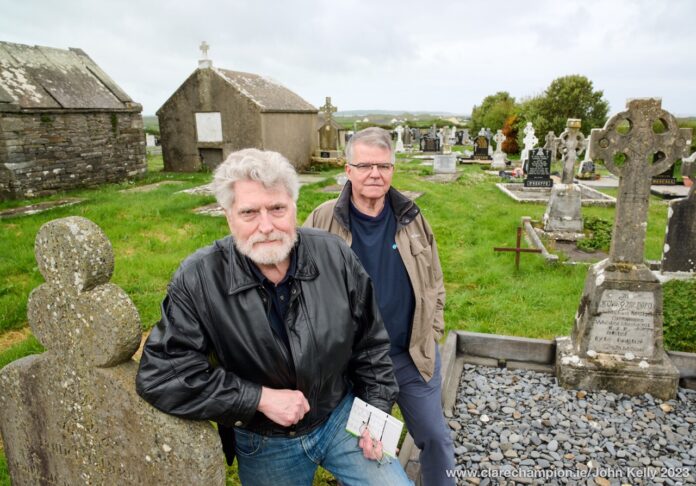AN APPEAL is being made for information on the final resting place of a 21-year-old Canadian, whose body was washed ashore at Doughmore Beach, more than 80 years ago.
James Hutton, a sailor, was among 207 people who lost their lives with the sinking, off County Donegal, of the troopship, the SS Nerissa on April 30, 1941. In the weeks and months that followed, bodies were discovered along the western seaboard, as far south as Clare. The remains of James Hutton were discovered on May 27, 1941, and laid to rest the same day in Clohanes Graveyard. In the intervening years, knowledge of the exact location of his burial plot has been lost. This week, retired officers of the Canadian Navy travelled to Clare in a bid to find the grave. They are hoping that local knowledge may identify exactly where James Hutton is buried and that the grave will be formally marked.
Retired Lieutenant Commander with the Royal Canadian Navy, William Dziadyk has written the history of the sinking of the Nerissa, which was torpedoed by a German u-boat during the Battle of the Atlantic. He travelled to Ireland with friend and colleague, David Lepine, to attend memorial services in Derry. The men, who are trustees of the Canadian Naval Memorial Trust, also visited Clohanes Graveyard and saw two possible locations of James’s grave.
William, together with Mayo journalist Anthony Hickey, has painstakingly researched the identities of the Nerissa fatalities who were washed ashore on the west coast. “Anthony has done enormous research at the National Archives in Ireland, looking at police reports and newspaper reports, including those from the Clare Champion,” William explained. “I wrote the book because nobody knew anything at all about the SS Nerissa. Details of the sinking were highly classified until 1985 and it’s only in recent years and with Anthony’s help that we have been able to identify the location of people like James Hutton.”
Official records show that James was born on April 5, 1920 to Walter and Elizabeth Hutton, both of whom had served in World War 1. At 17, James joined the Royal Canadian Navy, starting as a seaman then training as a telegraphist. Aboard the Nerissa, travelling from Nova Scotia to Liverpool, were James’s other classmates, all specialists in Morse Code. William believes they would have been supporting top-secret work at Bletchley Park, the base for the Allies’ code-breaking activities.
As part of their research, Anthony and William consulted police reports and the archives of this and other newspapers. In the June 7, 1941 edition of The Clare Champion under a headline, ‘Tragedy on the Clare Coast’ was a report on the discovery of a sailor’s body. It noted that the man was “of fine physique” and that his clothing carried the name ‘J Hutton’. A comparison of the description to details in naval personnel files confirmed the man as James. Efforts to find living relatives have, to-date, been unsuccessful. While William is not a relative, he described the link to the young sailor as “stronger than blood”. “You build up a connection with everyone who serves,” he said.
The Canadians spoke at Clohanes Graveyard to local man Senan McCarthy, who showed them two possible locations where James might be buried. Senan’s father was an undertaker and he believes he may have been involved in laying the young sailor to rest, 6,500km from home. “There was one grave, to the edge of the graveyard which had a metal cross with a circle going though it,” he said. “Going back many decades, people would always talk about it, wondering who was buried there. That cross is gone now and it probably rusted away over the years.”
Echoes of World War 2 are not unknown in the Doonbeg area. The McCarthy family recently hosted the relative of a survivor of an RAF plane crash at Carrowmore in 1941. “Grant Fleming is a cousin of one of the survivors, and has the same name,” Senan said. “Some time after the crash, my father, Simon, had found a pen engraved with the words ‘From Betty to Grant’, dated 1941. We were able to give that to his cousin and it really meant a lot to him.”
Senan hopes that knowledge within the local area might shed light on the resting place of James Hutton, whose name included on the Halifax Memorial to Canadian service people who died at sea.
William and David also travelled to Mayo to meet Anthony, and visit a number of other graves of those who were lost from the Nerissa.
In the final paragraph of the updated edition of, SS Nerissa, The Final Crossing, William writes: “With the analysis and evidence provided by Anthony Hickey and myself, we are hopeful that the Commonwealth War Graves Commission with the support of the British, Canadian and Irish authorities will someday act appropriately and provide the graves of the fallen with recognition honouring their lives and sacrifices. We will remember them.”


